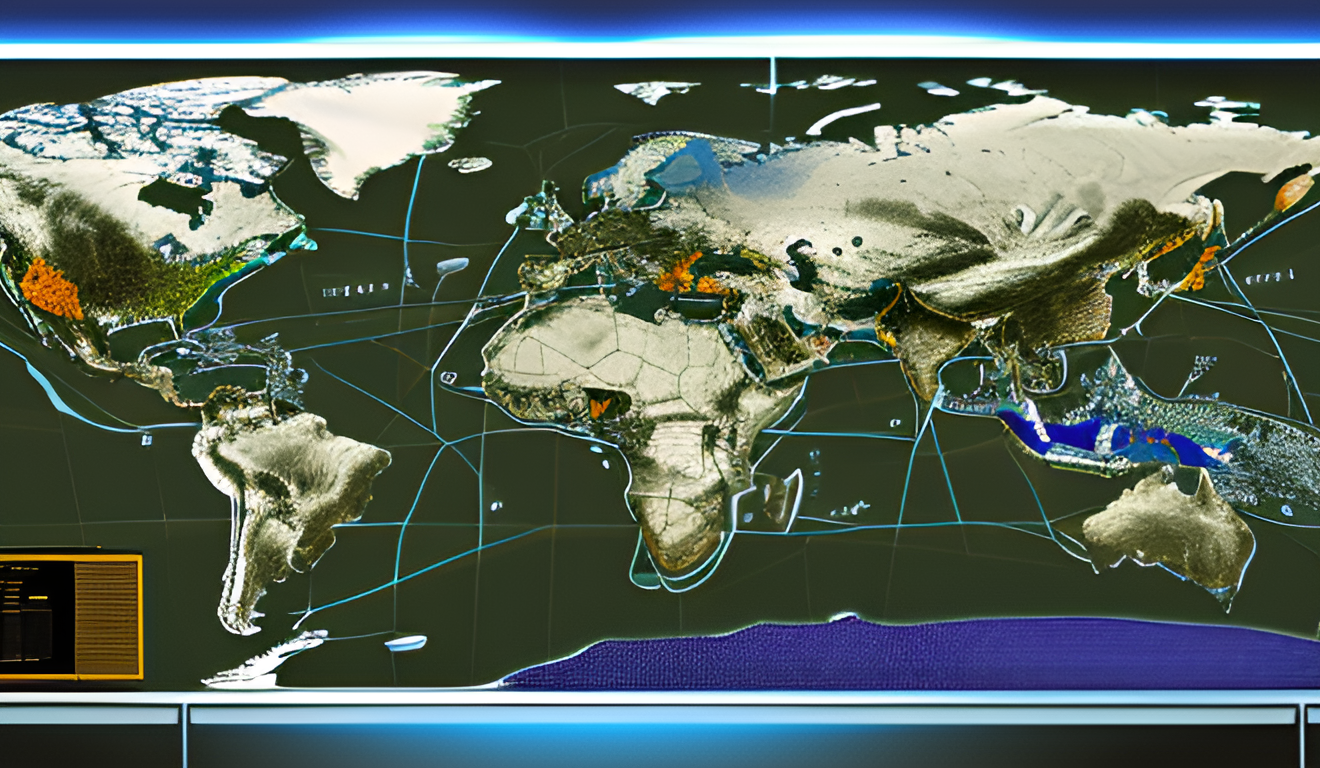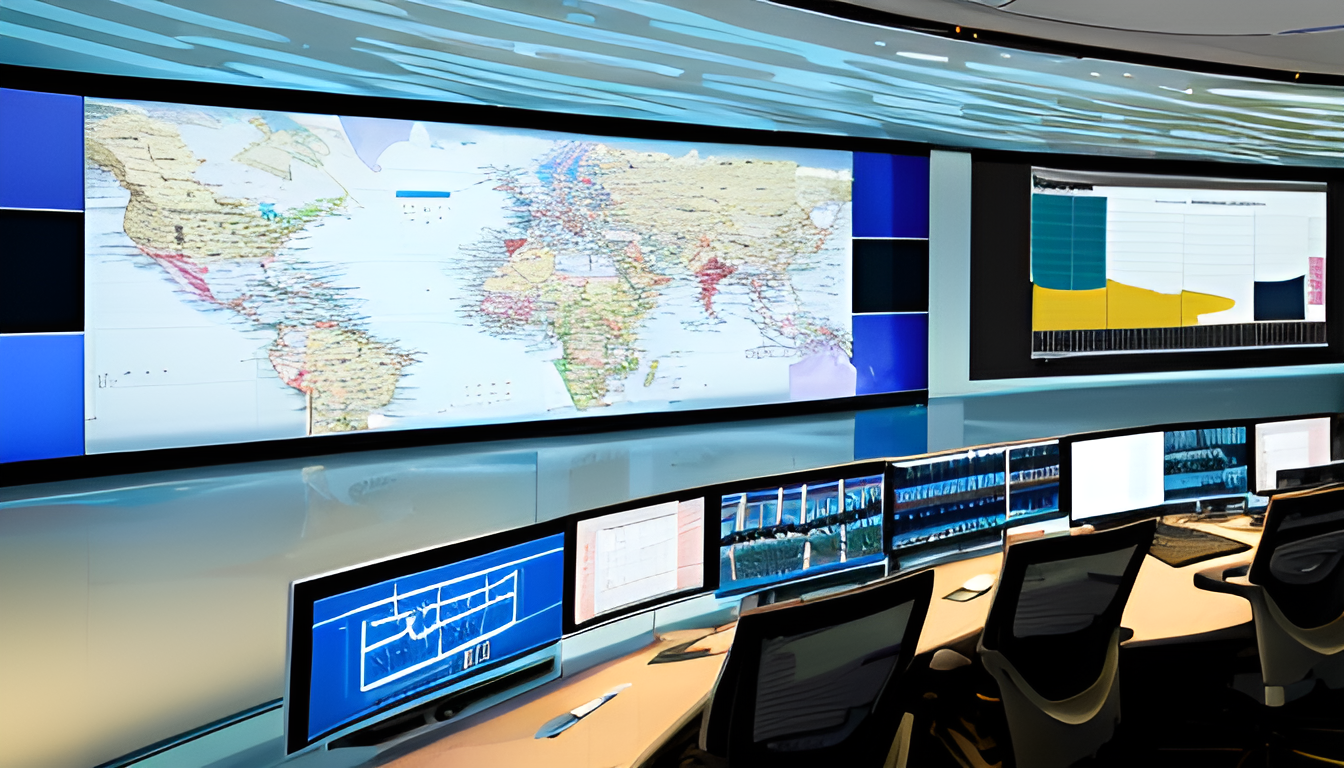AI in Analyzing 20th Century Global Conflicts

In the age of information, artificial intelligence (AI) is revolutionizing our understanding of global conflicts that shaped the 20th century. Imagine having a tool that can sift through mountains of data in seconds, uncovering patterns and insights that even the most seasoned historians might miss. This is not just a dream; it’s a reality made possible by AI technologies. By leveraging advanced algorithms, historians can now analyze conflicts with unprecedented depth and clarity.
AI’s ability to process vast amounts of data allows researchers to connect the dots between various events, social movements, and political decisions. For instance, consider how the analysis of social media during significant events like the Vietnam War or the Cold War can reveal public sentiment and reactions in real-time. This dynamic approach to historical analysis not only enhances our understanding of past conflicts but also provides valuable lessons for future conflict resolution.
Furthermore, the methodologies employed by AI in analyzing these conflicts are diverse. From text mining to predictive modeling, AI tools can transform unstructured data into structured insights. For example, through text mining, researchers can extract critical information from countless documents, while predictive modeling can forecast potential conflicts by recognizing historical patterns. This dual capability of AI not only enriches historical narratives but also helps in crafting strategies for peace and conflict prevention.
As we delve deeper into the implications of AI in conflict studies, it’s essential to recognize both the opportunities and challenges it presents. While AI offers a powerful lens for understanding complex historical events, it also raises important ethical questions regarding bias and data privacy. As we harness the power of AI, we must remain vigilant in ensuring that our analyses are fair, accurate, and respectful of the sensitive nature of historical data.
In conclusion, the integration of AI into the study of 20th-century global conflicts is not merely an enhancement; it is a transformative shift that promises to reshape our historical narratives and inform future peace initiatives. By embracing this technology, we stand at the precipice of a new era in historical analysis, one that holds the potential for deeper understanding and more effective conflict resolution strategies.
The Role of AI in Historical Analysis
Artificial intelligence is revolutionizing the landscape of historical analysis, providing historians with tools that enhance their understanding of complex events. Traditionally, historians have relied on meticulous research, combing through archives and documents, which can be a time-consuming and often tedious process. However, with the advent of AI, this labor-intensive task is being transformed into a more efficient and insightful endeavor.
Imagine being able to sift through millions of documents in the blink of an eye! AI technologies, such as machine learning and natural language processing, allow researchers to process vast amounts of data quickly and accurately. These tools help identify patterns and trends that might be invisible to the naked eye, making it possible to uncover hidden narratives and connections between events.
For instance, AI can analyze historical texts to determine the frequency of certain keywords or themes, revealing shifts in public sentiment over time. This capability not only enhances our understanding of specific conflicts but also enriches the broader historical narrative. By utilizing AI, historians can ask new questions and explore previously uncharted territories of research.
Furthermore, the integration of AI in historical analysis is not just about speed; it’s also about depth. With advanced algorithms, AI can perform text mining, extracting relevant information from unstructured data sources like social media posts, news articles, and personal diaries. This multi-faceted approach provides a comprehensive view of historical events, capturing the voices of those who lived through them.
As we embrace these technological advancements, it’s essential to recognize the potential risks and ethical considerations involved. AI must be used responsibly to ensure that historical interpretations remain accurate and unbiased. Nevertheless, the role of AI in historical analysis is undeniably transformative, paving the way for a future where our understanding of the past is not only deeper but also more nuanced.
Data Sources for Conflict Analysis
When it comes to analyzing conflicts, having the right data sources is absolutely vital. Think of these sources as the building blocks of our understanding; without them, we’re just guessing in the dark. In the digital age, we are fortunate to have a plethora of data at our fingertips, which can be harnessed to reveal patterns and trends that traditional methods might miss. Some of the most valuable data sources include:
- Archives: Historical archives contain a wealth of documents, letters, and reports that provide context and depth to the events of the past.
- Social Media: Platforms like Twitter and Facebook offer real-time insights into public sentiment and reactions during conflicts, acting as a digital pulse of society.
- News Reports: Articles from various media outlets provide narratives and perspectives that can help piece together the multifaceted nature of conflicts.
Each of these sources contributes unique insights. For instance, archives may offer a more formal viewpoint, while social media can capture the raw emotions and immediate reactions of individuals caught in the chaos. By leveraging artificial intelligence, researchers can sift through these vast amounts of data, identifying correlations and trends that might otherwise remain hidden.
Moreover, the integration of AI allows for a more nuanced analysis of these data sources. For example, algorithms can analyze sentiment from social media posts, categorizing them as positive, negative, or neutral. This sentiment analysis can be invaluable in understanding how different populations perceive and react to conflicts. The result? A richer, more comprehensive picture of historical events that goes beyond mere dates and facts.
In conclusion, the diverse data sources available today not only enhance our understanding of 20th-century conflicts but also empower historians and researchers to draw connections and conclusions that were previously unimaginable. The future of conflict analysis is bright, thanks to the incredible potential of AI and the wealth of data at our disposal.
Text Mining and Natural Language Processing
In the digital age, text mining and natural language processing (NLP) have emerged as pivotal tools for historians and researchers delving into the complexities of 20th-century global conflicts. These AI-driven methodologies enable the extraction of meaningful insights from vast repositories of unstructured text, such as historical documents, articles, and even social media posts. Imagine sifting through mountains of data, trying to find the golden nuggets of information that could change our understanding of a significant event—this is where text mining steps in to save the day.
Text mining allows researchers to analyze patterns and trends by processing large datasets quickly and efficiently. By employing algorithms that can identify keywords, phrases, and themes, historians can uncover connections that may have previously gone unnoticed. For example, during the analysis of World War II, text mining can help highlight recurring themes in propaganda materials, revealing how narratives were crafted to influence public sentiment. This not only enriches our understanding of the conflict but also provides a lens through which we can view the societal impact of these narratives.
On the other hand, NLP takes this a step further by enabling machines to understand and interpret human language. Through techniques such as sentiment analysis, NLP can gauge public opinion during conflicts, offering a window into the emotional landscape of societies at war. This is particularly useful for historians looking to understand how civilian populations reacted to events, as it provides a more nuanced view of the human experience during tumultuous times.
In summary, the combination of text mining and NLP is revolutionizing how we approach historical analysis. These technologies not only streamline the research process but also enhance the depth and accuracy of our understanding of global conflicts. As we continue to refine these tools, the potential for new discoveries and insights into our past becomes limitless.
Sentiment Analysis in Conflict Studies
Sentiment analysis plays a pivotal role in understanding the emotional landscape during conflicts. By examining public sentiment, researchers can gauge how societies react to war and violence, providing crucial insights into the human experience amidst chaos. Imagine being able to capture the collective feelings of a nation in turmoil—this is precisely what sentiment analysis enables.
Through the use of advanced algorithms, AI can sift through vast amounts of data from various sources such as social media posts, news articles, and historical documents. This analysis reveals not only the prevailing emotions but also the nuances of public opinion over time. For instance, during a conflict, sentiment analysis can highlight shifts in attitudes towards military actions, humanitarian efforts, or peace negotiations.
Consider the following key aspects of sentiment analysis in conflict studies:
- Public Opinion Tracking: By monitoring sentiment trends, researchers can identify how public opinion evolves during different phases of a conflict.
- Impact Assessment: Understanding societal attitudes helps historians and policymakers assess the impact of war on civilian populations, informing future strategies for conflict resolution.
- Media Influence: Analyzing sentiment in media coverage can reveal biases and the framing of conflicts, shedding light on how narratives are constructed.
Moreover, sentiment analysis can be particularly valuable in identifying potential flashpoints for future conflicts. By recognizing patterns in public sentiment, analysts can provide early warnings to policymakers, enabling them to take proactive measures. This capability not only enhances our understanding of past conflicts but also equips us with tools to navigate future challenges more effectively.
In summary, sentiment analysis is a game-changer in conflict studies, offering a window into the emotional and social dynamics of societies at war. As AI continues to evolve, the depth and accuracy of sentiment analysis will only improve, allowing for a more comprehensive understanding of the complex tapestry of human emotions during times of conflict.
Automated Content Classification
Automated content classification is revolutionizing the way historians and researchers approach the vast sea of historical documents related to global conflicts. Imagine sifting through mountains of text, photographs, and media from the 20th century—it’s a daunting task! But with the power of artificial intelligence, this process becomes not only manageable but also incredibly efficient.
At its core, automated content classification employs sophisticated algorithms that can categorize and organize historical materials based on predefined criteria. This technology allows researchers to quickly identify relevant documents, making it easier to focus on critical analysis rather than getting lost in data organization. For example, AI can classify documents into various categories such as:
- Military strategies
- Political speeches
- Public opinion articles
- Diplomatic correspondence
By automating this classification process, historians can uncover hidden patterns and connections that might otherwise go unnoticed. The implications are profound: researchers can now access a more structured overview of conflicts, leading to richer insights and a deeper understanding of the socio-political landscape of the time.
Furthermore, the use of automated content classification can significantly enhance collaborative efforts among historians. Imagine a network of researchers across the globe sharing classified data in real-time. This not only enriches individual studies but also contributes to a more comprehensive understanding of historical narratives. In essence, AI acts as a powerful ally, enabling historians to piece together the intricate puzzle of 20th-century conflicts with unprecedented speed and accuracy.
As we continue to harness the capabilities of AI in this field, the future looks promising. Automated content classification is not just a tool; it’s a gateway to unlocking the complexities of our past, ensuring that the lessons learned from history are accessible and actionable for future generations.
Predictive Modeling of Conflicts
Predictive modeling of conflicts is like having a crystal ball that allows researchers and policymakers to glimpse into the future of global tensions. By leveraging the power of artificial intelligence, analysts can sift through mountains of historical data, identifying patterns and trends that might otherwise go unnoticed. This process not only enhances our understanding of past conflicts but also equips us with the tools to foresee potential crises before they escalate.
Imagine being able to predict the outbreak of conflict in a region by analyzing various socio-political factors such as economic instability, historical grievances, and even social media sentiment. AI algorithms can process this information at lightning speed, offering insights that are crucial for proactive intervention. For instance, countries can better allocate resources and diplomatic efforts to areas of heightened risk, potentially averting violence and fostering stability.
To illustrate how predictive modeling works, consider the following key factors that AI analyzes:
- Historical Data: Past conflicts provide a wealth of information that AI can use to identify recurring patterns.
- Socio-Political Indicators: Economic conditions, governance quality, and social cohesion are essential metrics in conflict prediction.
- Public Sentiment: Analyzing social media and news reports helps gauge the mood of the populace, which can be a precursor to unrest.
Moreover, the implications of predictive modeling extend beyond just understanding conflicts. It also plays a vital role in conflict resolution strategies. By anticipating where tensions may arise, stakeholders can engage in diplomatic dialogues, peacekeeping missions, or humanitarian efforts well in advance. The goal is to create a more stable world where conflicts are not merely reacted to but are preemptively addressed.
In conclusion, as AI continues to advance, the potential for predictive modeling in conflict studies will only grow. This technology promises a future where we can not only understand the past but also shape a more peaceful tomorrow.
Ethical Considerations in AI Analysis
As we delve into the world of artificial intelligence (AI) and its role in analyzing 20th-century global conflicts, it’s crucial to pause and consider the ethical implications that come with it. While AI can significantly enhance our understanding of historical events, it also raises a myriad of ethical questions that must be addressed. For instance, the potential for bias in AI algorithms can lead to skewed interpretations of conflicts, distorting our understanding of the past.
Imagine a historian relying on AI to analyze a vast database of documents related to World War II. If the AI system is trained on biased data, it may inadvertently favor certain narratives over others, leading to an incomplete or inaccurate portrayal of the conflict. This highlights the importance of understanding and mitigating bias in AI systems. Researchers must be vigilant in identifying the sources of bias and ensuring that the algorithms used for analysis are as neutral as possible.
Another significant concern is data privacy. When dealing with sensitive historical data, especially those related to conflicts, maintaining the privacy of individuals and communities is paramount. Researchers must adhere to strict ethical standards to ensure that the data used in AI analysis does not violate privacy rights or expose vulnerable populations. This responsibility extends to how data is collected, stored, and utilized in AI models.
Moreover, the implications of automated decision-making in conflict analysis cannot be overlooked. As AI systems take on more analytical roles, there is a risk that their recommendations could influence policy decisions without adequate human oversight. This raises questions about accountability and the potential consequences of relying on machines to make sense of complex human experiences.
In summary, while AI holds immense potential for enriching our understanding of historical conflicts, we must approach its application with a critical eye. Addressing bias, ensuring data privacy, and maintaining ethical standards are essential steps in responsibly leveraging AI for historical analysis. As we move forward, it’s vital that researchers and policymakers work together to navigate these ethical challenges, ensuring that the technology serves to enhance our understanding of history rather than distort it.
Addressing Bias in AI Algorithms
Bias in AI algorithms is a pressing concern that can significantly distort historical analysis and lead to misinterpretations of conflicts. Imagine trying to piece together a complex jigsaw puzzle, but some of the pieces are missing or incorrectly shaped; that’s what bias does to our understanding of history. It’s essential to recognize that algorithms are only as good as the data fed into them. If the data reflects societal prejudices or incomplete narratives, the resulting analysis will be skewed.
To tackle this issue, researchers must first identify the sources of bias. These can stem from various factors, including:
- Data Selection: Choosing which data to include can inherently favor certain perspectives over others.
- Algorithm Design: The way an algorithm is structured can unintentionally prioritize specific outcomes.
- Human Bias: The biases of those who develop and train AI systems can seep into the algorithms themselves.
Addressing these biases is not just a technical challenge; it requires a multidisciplinary approach that includes historians, ethicists, and data scientists working together. For instance, implementing regular audits of AI systems can help identify and rectify biases. By continuously refining the data sets and algorithms, we can strive for a more accurate and fair representation of historical events.
Moreover, fostering transparency in AI processes allows stakeholders to understand how conclusions are drawn. This transparency can build trust and ensure that the narratives constructed from AI analyses are not only insightful but also responsible. In the end, the goal is to create a more nuanced understanding of history that acknowledges diverse perspectives and experiences, paving the way for a richer dialogue about our past.
Data Privacy and Ethical Standards
In the age of data-driven research, maintaining data privacy and adhering to ethical standards is paramount, especially when it comes to analyzing sensitive historical data related to conflicts. As historians and researchers increasingly rely on artificial intelligence to sift through vast amounts of information, the importance of ethical considerations cannot be overstated. Imagine diving into a treasure trove of documents, only to find that some of those records contain personal information about individuals who lived through those tumultuous times. How do we navigate this delicate balance?
One of the primary concerns involves the potential misuse of personal data. Researchers must ensure that any data collected is handled responsibly and in compliance with existing privacy laws. This means anonymizing data where possible and being transparent about how information is used. For instance, when using social media posts or news articles as data sources, it’s crucial to consider the context in which this information was shared. Were individuals expressing their true feelings, or were they influenced by external factors? Understanding this context is vital for ethical analysis.
Moreover, the ethical implications of automated decision-making in AI technologies present another layer of complexity. Decisions made by AI can have far-reaching effects, and researchers must be vigilant about the potential biases embedded within these systems. If an algorithm is trained on biased data, it can perpetuate those biases in its analysis, leading to skewed interpretations of historical events. This is why it’s essential to continuously evaluate and refine AI algorithms to ensure they produce fair and accurate representations.
In summary, the intersection of data privacy and ethical standards in AI research is a critical frontier that historians must navigate. By prioritizing responsible data use and ethical considerations, researchers can harness the power of AI while honoring the complexities of human experiences during conflicts. As we look to the future, it’s clear that a thoughtful approach to these issues will pave the way for more reliable and meaningful analyses of our past.

The Future of AI in Conflict Studies
As we look ahead, the future of AI in conflict studies is not just promising; it’s downright exhilarating! Imagine a world where artificial intelligence can dissect the intricate web of global conflicts with the precision of a surgeon. With the rapid advancement of technology, AI is set to revolutionize how we analyze and understand conflicts from the 20th century and beyond. It’s like having a crystal ball that not only reveals what happened but also predicts what might happen next.
One of the most exciting prospects is the enhancement of machine learning algorithms that can analyze vast datasets in real-time. This capability allows researchers to identify emerging trends and patterns that were previously invisible. For instance, by examining social media interactions during conflicts, AI can provide a nuanced view of public sentiment, helping us understand how narratives evolve over time. This is crucial because, as we know, history is often shaped by the stories people tell.
Furthermore, AI’s ability to integrate diverse data sources—from historical archives to contemporary news reports—will enable a more holistic view of conflicts. Picture a dynamic dashboard where historians can visualize data, analyze relationships, and even simulate outcomes based on various scenarios. This interactive approach not only makes historical analysis more engaging but also empowers policymakers with actionable insights.
However, as we embrace these advancements, we must remain vigilant about the ethical implications of using AI in conflict studies. It’s vital to ensure that the algorithms we develop are free from bias and uphold the highest standards of data privacy. The last thing we want is for the tools designed to illuminate our past to cast shadows over the truth.
In conclusion, the journey of integrating AI into conflict studies is just beginning. As technology evolves, so too will our methodologies, leading to a richer, more informed understanding of the complexities surrounding global conflicts. The future is bright, and with AI by our side, we are better equipped to navigate the turbulent waters of history.
Frequently Asked Questions
- How does AI enhance the analysis of 20th-century conflicts?
AI enhances conflict analysis by processing large amounts of data quickly and identifying patterns that may not be visible through traditional methods. This allows historians to gain deeper insights into the causes and effects of conflicts, ultimately reshaping historical narratives.
- What types of data sources are utilized in AI conflict analysis?
Various data sources are used, including historical archives, social media posts, and news articles. These diverse inputs provide a rich foundation for AI algorithms to analyze trends and insights that traditional research methods might overlook.
- What is sentiment analysis, and why is it important?
Sentiment analysis gauges public opinion during conflicts by analyzing emotions expressed in text data. This is crucial because it helps historians and policymakers understand societal attitudes and the impact of war on civilian populations.
- Are there ethical concerns associated with using AI in historical analysis?
Yes, there are significant ethical concerns, including potential biases in AI algorithms, data privacy issues, and the implications of automated decision-making. Researchers must navigate these challenges to ensure responsible and fair use of AI in historical contexts.
- How can predictive modeling assist in conflict prevention?
Predictive modeling uses historical data and socio-political factors to forecast potential conflicts. By identifying patterns, it can provide valuable insights that help policymakers develop strategies for conflict prevention and resolution.













